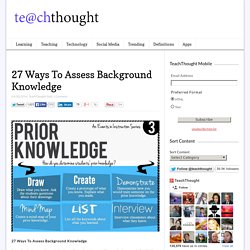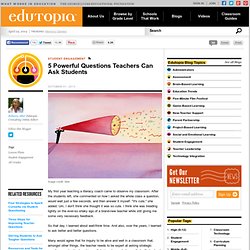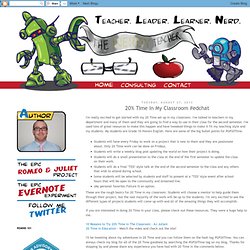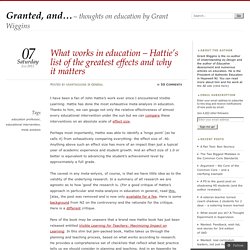

27 Ways To Assess Background Knowledge. 27 Ways To Assess Background Knowledge Assessing background knowledge is an often misunderstood idea, and subsequently fumbled as a process.

Background knowledge is a product of the experiences–academic and otherwise–that a student brings to a lesson. These provide both knowledge in terms of content, as well as schema in terms of analogs students can use to make sense of new ideas. The purpose of assessing background knowledge is not to get everyone on the “same page,” but rather to make visible the nature of what a student knows (rather than a list or academic labels like “proficient). This makes it possible to create personalized learning pathways for students as each learner approaches new–or familiar–thinking on their own terms. From a planning point of view, it can also allow teachers to identify knowledge gaps, prioritize standards, and revise imminent lessons and units in response.
Mia MacMeekin created the following infographic that offers 27 ways to assess background knowledge.
5 Powerful Questions Teachers Can Ask Students. My first year teaching a literacy coach came to observe my classroom.

After the students left, she commented on how I asked the whole class a question, would wait just a few seconds, and then answer it myself. "It's cute," she added. Um, I don't think she thought it was so cute. I think she was treading lightly on the ever-so shaky ego of a brand-new teacher while still giving me some very necessary feedback. So that day, I learned about wait/think time.
Many would agree that for inquiry to be alive and well in a classroom that, amongst other things, the teacher needs to be expert at asking strategic questions, and not only asking well-designed ones, but ones that will also lead students to questions of their own. I also learned over the years that asking straightforward, simply-worded questions can be just as effective as those intricate ones. The Best 1:1 Device is a Good Teacher. Photo credit: iStockPhoto Over the course of two years, I, along with the Burlington Public Schools tech team, had the opportunity to meet and connect with over one hundred schools.

These discussions would usually involve what device works best in the classroom and how the iPad is affecting teaching and learning outcomes. Frequently this conversation focuses on the most effective hardware for teaching and learning. While this is an important decision to make, it should not be the focus. In fact, the best devices a school can employ are great teachers. Smashing the State of the Art We have reached a point in education technology where devices are, for the most part, adaptable. This hypothetical simulation is a great example of how little hardware actually matters any more. Innovation on the Fly To illustrate the points I’ve made, I'll share a true story. Self-Paced Professional Development. 20% Time In My Classroom. I'm really excited to get started with my 20 Time set up in my classroom.

I've talked to teachers in my department and many of them said they are going to find a way to use in their class for the second semester. I've used tons of great resources to make this happen and have tweaked things to make it fit my teaching style and my students. My students are Grade 10 Honors English. Here are some of the big bullet points for #GP20Time. Students will have every Friday to work on a project that is new to them and they are passionate about. These are the rough basics for 20 Time in my classroom. If you are interested in doing 20 Time in your class, please check out these resources.
KWHLAQ-chart-template.jpg 800×600 pixels. What works in education – Hattie’s list of the greatest effects and why it matters. I have been a fan of John Hattie’s work ever since I encountered Visible Learning.

Hattie has done the most exhaustive meta-analysis in education. Thanks to him, we can gauge not only the relative effectiveness of almost every educational intervention under the sun but we can compare these interventions on an absolute scale of effect size. Perhaps most importantly, Hattie was able to identify a ‘hinge point’ (as he calls it) from exhaustively comparing everything: the effect size of .40. Anything above such an effect size has more of an impact than just a typical year of academic experience and student growth. And an effect size of 1.0 or better is equivalent to advancing the student’s achievement level by approximately a full grade. The caveat in any meta-anlysis, of course, is that we have little idea as to the validity of the underlying research.
Can you guess the next two items on the rank order list? Where Learning Happens. The Fantastic Flying Books of Mr Morris Lessmore. The Myth of 'I'm Bad at Math' - Miles Kimball & Noah Smith. “I’m just not a math person.”

We hear it all the time. And we’ve had enough. Because we believe that the idea of “math people” is the most self-destructive idea in America today. The truth is, you probably are a math person, and by thinking otherwise, you are possibly hamstringing your own career. Worse, you may be helping to perpetuate a pernicious myth that is harming underprivileged children—the myth of inborn genetic math ability. Is math ability genetic? How do we know this? Different kids with different levels of preparation come into a math class. Five Keys to Successful Social and Emotional Learning. Pamela Randall: Social-emotional skills are the essential skills for success in school, work and life.

Natalie Walchuk: Social-emotional learning centers their mind and body. It reduces their emotional tension, so they can be open to new content and material. We find that academic outcomes increase exponentially when students are nurtured, loved and cared for. That we get much more out of them when we first address social-emotional needs. So for us, it's actually an academic intervention, and not just an emotional one. Pamela: If we expect students to be college and career ready, it's important for us to focus on these skills and competencies: Self-Awareness; Self-Management; Social Awareness; Relationship Skills; and Responsible Decision-Making.
Brene Brown: The power of vulnerability. Piktochart.